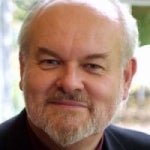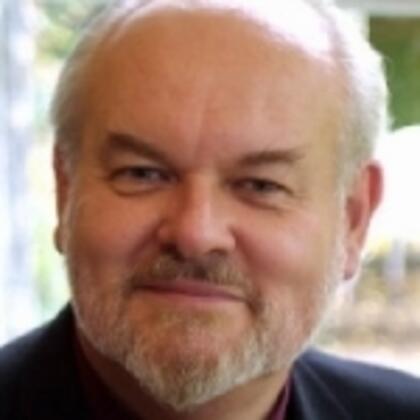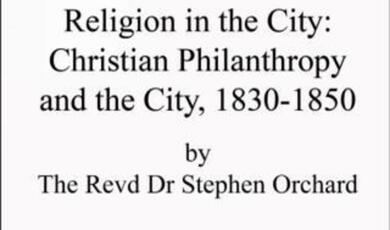The Tree of Life
Share
- Details
- Transcript
- Audio
- Downloads
- Extra Reading
Illuminating one of the City of London Festival’s main themes, the Bishop of London will explore trees as spiritual, mystical and religious symbols of faith and life.
Download Transcript
1July 2013
The Tree of Life
Dr Richard Chartres
This year’s festival has three themes: Conflict and Resolution, City Walls, and Trees. Tonight my focus is on trees and in particular the Tree of Life but, if you will forgive the pun, I also intend to branch out into the theme of conflict resolution.
Trees stir deep passions. In one of the favourite fantasy books of this age of Middle Earth, trees play a significant symbolic role.
Among the most attractive characters in Lord of the Rings is Treebeard, the Ent and ancient tree shepherd. Tolkein was of course a scholar of Anglo-Saxon and “ent” is derived from the word for giant. The Anglo-Saxon poem The Ruin contains a phrase used of crumbling Roman cities: orthanc enta geweorc – the work of cunning giants.
Under the shadow of Orthanc, the tower which stands in the ring of Isengard [and which you can now build out of Lego bricks], the off-white wizard Saruman is collecting fuel for his infernal machines which are mass-producing an army of fighting uruk-hai.
The Orc foreman obsequiously observes, “The trees are strong my lord. Their roots go deep”.
Saruman replies, “Rip them all down”.
The world of living, growing things is sacrificed to dreams of domination in a scene which reflects what has actually happened to the forests which used to cover much of the earth, and not least England’s green and pleasant land.
Before the Roman conquest, about two-thirds of lowland Britain were forested with Kipling’s “oak, ash and thorn” but also with birch, Scots pine, hazel, beech, hornbeam and, possibly, sweet chestnut (although this is disputed). The Romans introduced other species, notably lime, plane, box, elm and poplar.
Tudor industry, construction, charcoal-burning for fuel and, especially, ship-building led to considerable deforestation and concern about the disappearance of such a crucial resource. John Evelyn published his Sylva or A Discourse of Forest Trees and the Propagation of Timber in His Majesty’s Dominions in 1664.
Since Evelyn’s time there has been a spate of publications, but probably none to compare with The Trees of Great Britain and Ireland in seven volumes published between 1906 and 1913. The centenary of this exhaustive work has been recently celebrated by The Society of Irish Foresters in a limited edition reprint. The promoter of the project, Henry Elwes of Colesbourne Park in Gloucestershire, wanted his book to be a “life history of every tree that had been cultivated in this country from the seed to the stage at which it was converted or convertible into timber”. His chosen collaborator in this massive task was Dr Augustine Henry, an authority on the flora of China. No expense was spared and the result is a most beautiful book recording many individual specimens now, alas, lost.
My theme however is not so much scientific dendrology as the symbolic aspect of trees in the various cultures of the world.
While working on the restoration of St Ethelburga’s Church, here in the City of London, I tried to identify symbols that would express its purpose as a Centre of Reconciliation and Peace. The Church was a victim of an IRA bomb in 1993. St Ethelburga’s had survived the Great Fire and the Blitz but was almost entirely destroyed by an explosive device detonated as a result of an ancient quarrel which had a religious dimension. It used to be fashionable to say that the religious element in the Irish conflict was really reducible to economic and social factors but in the 21st century we have come to understand once again the power of religion to bind people together and contribute to the demonization of those outside the tribe. After becoming Bishop of London in1995, and greatly assisted by the late Cardinal Basil Hume, I launched an appeal to restore the church as a place where followers of all religions would feel able to come to co-operate in preventing and transforming those conflicts which had a religious dimension. In the 1990’s, hard-headed people in the City of London could not understand why such a centre might be necessary. Religion for them was harmless and a slightly eccentric leisure-time interest. 9/11 changed all that.
As I searched for common symbols in the major world religions and cultures, it was the tree that continually made its appearance. “Trees are good to think with” says the anthropologist Maurice Bloch.
The root of the tree delves, and the shoot reaches up. I have just reached this point with a black poplar, planted in the garden to celebrate the Diamond Jubilee. Then the tree will stretch out under heaven in four directions. The tree connects this Middle Earth with the heavens and with the underworld. It can be seen as a cosmic axis of the kind celebrated in the maypole. Then, as in the vision of the prophet Daniel, the axis of the world can also be the world tree:
“I saw and behold, a tree in the midst of the earth, and the height thereof was great. The tree grew and was strong and the height thereof reached unto heaven and the sight thereof to the end of all the earth. The leaves thereof were fair and the fruit thereof much, and in it was meat for all. The beasts of the field had a shadow under it and the fowls of the heaven dwelt in the boughs thereof, all flesh was fed of it” (Daniel IV: 10-12).
Perhaps the most vivid picture of the world tree is painted in Norse mythology. Both in the poetic Edda (composed from ancient sources in the 13th century) and also the prose Edda by the priest Snorri Sturluson, Yggdrasil is an immense ash tree at the centre of the world.
‘Ygg’ was one of the names of the god Odin, and ‘drasil’ means “horse”. One of the poems of the poetic Edda describes how Odin once sacrificed himself to himself by hanging on a tree which is identified with Yggdrasil:
“I know that I hung on a windy tree
Nine long nights,
Wounded with a spear, dedicated to Odin,
Myself to myself,
On that tree where no man knows
From where its roots run.”
Odin then describes how he had no food or drink and, peering downwards, he took up the runes, “screaming as I took them”. Trees are frequently connected, as in this story, with the search for wisdom.
Odin declares that Yggdrasil “suffers agony more than men know. A hart preys upon it from above and, below, the dragon, Nidhogg (‘malice-striker’) gnaws at the roots.
The references to Yggdrasil are scattered throughout Norse Literature, and attempts to construct a comprehensive and consistent picture of the world tree probably over-systematise a poetic concept.
The world ash certainly unites a three-decker universe familiar from other mythologies. There are sky-gods; there is homo sapiens, closely connected to the humus or earth; and then there is the underworld. The eighteenth century three- decker pulpit perhaps unconsciously traced the same pattern, with the sermon delivered from the topmost position, the gospel read from the middle desk and community notices given out below.
In Greek mythology, the chief sky god Zeus is also associated with a tree, the oak. In his ancient sanctuary of Dodona high up in Epirus in North West Greece, Zeus communicated through the susurration of the wind in the leaves of the oak. The Iliad in Book XVI records that the priests of Dodona went barefoot and slept on the floor of the sanctuary to encourage revelatory dreams (Iliad XVI: 233).
The most recently canonised saint of the Greek Orthodox Church, St Nectarius of Aegina, taught his disciples to listen to the song of trees as a way of entering into a state of contemplation.
Other deities had their favoured tree. For Athene, it was the olive. Here I must confess that, on a recent visit to the Acropolis in Athens, I was tempted and I fell. You will remember that there was a contest between Athene and Poseidon for the patronage of the city. Poseidon the sea god struck the earth with his trident and a well appeared, but the water was salty so the prize went to Athene who presented the city with an olive tree. The Bishop of Birmingham and I were on an official visit to the Church of Greece, exploring among other things the possibility of establishing a hospice for seriously ill children. We were in our cassocks on the Acropolis when we were surrounded by a large crowd of Japanese tourists. They began prodding us and, I suppose imagining that we were some kind of tourist attraction, took photographs and demanded to know who we were. I said that I was the priest of Athene and Birmingham represented Poseidon and that we met once a year to rehearse the old quarrel. To my horror I saw that notes were being taken as well as the photos, and I imagine that Mothers’ Union meetings the length and breadth of Japan have since been entertained by the astonishing apparition.
Other gods had their proper trees. Demeter was associated with the fig, Hera with the willow and, famously, Apollo with the palm under which he was born in the island of Delos, and with the laurel which played a part in the apparatus of his oracle at Delphi.
Symbolic trees with their associations with pagan worship in Europe were sometimes the victims of the advance of Christianity.
In his influential life of Martin of Tours, Sulpicius Severus records a confrontation over the felling of a pine tree in about 390, at the end of a century in which the Christian faith had moved from being banned and subject to persecution to being the official religion of the Roman Empire. From locating the sacred in natural features, the Christian faith shifted the locus of sanctity to holy people and to relics of the saints.
The destruction of the Donar oak at Geismar in Hesse by Boniface in 724 and the Irminsul near Paderborn by Charlemagne in 772 were turning- points in the imposition of Christianity on the northlands. The latter tree, destroyed as part of Charlemagne’s war against the Saxons, was described by Rudolf of Fulda as “a universal column as if upholding all things”.
Yet trees also play a prominent part in the Judaeo-Christian narrative. Genesis in the beginning describes two trees in the Paradise Garden, while at the very end of the New Testament we encounter in the Book of Revelation the tree in the midst of the City whose leaves are for the healing of the nations. (Revelation XXII: 2) There was “the tree of life which bare twelve manner of fruits and yielded her fruit every month, and the leaves of the tree were for the healing of the nations” (Revelation XXII: 2).
In the myth of the Paradise Garden we are presented with two trees: the Tree of Life and the Tree of Knowledge. The fruit of the Tree of Life was true knowledge of the divine creation. This is what the Biblical tradition regards as Wisdom. “Wisdom is a tree of life to them that lay hold upon her” (Proverbs III:18). We have already seen how the tree is symbolically connected with the search for knowledge, and this is also a theme in Buddhism. Under the shelter of the Bodhi tree (an ancient fig), Gautama Buddha attained enlightenment. I have sat under a living descendant of the original Bodhi tree where it is still venerated in Anuradhapura, the former capital of Sri Lanka.
The Tree of Life is associated with the fruit of wisdom. What of the Tree of Knowledge? This is knowledge detached from its source and context which, according to the first book of Enoch, “caused much bloodshed on the earth”. The knowledge from the second tree is partial and fragmented. It is knowledge only of a god-forsaken world, in which human beings have themselves assumed the role of gods. In the process, of course, they have discovered that, abstracted from the Creator and Source of Life, their destiny is death.
In the Book of the Wisdom of Solomon it says that wisdom, the fruit of the Tree of Life, “renews all things; in every generation she passes into holy souls and makes them friends of God and prophets” (Wisdom VII: 27).
The notion of wisdom is, however, problematic in our own day. It is often associated with old people and with a pre-modern cast of mind, and fits awkwardly in our contemporary culture of youth and innovation, just as trees themselves often fall victim to the demand for “development”.
But still our specialised knowledge and our know-how continually come up against questions of ethics, value and beauty. We struggle to relate our particular knowledge to what is needed to shape and ensure the flourishing of whole persons. There is also frequently tension with the concept of the common good and long-term perspectives.
Wisdom should serve to combine a sense of overall meaning and connectedness with discernment and guidance in specific situations. But the poet T.S.Eliot lamented what he saw as a failure to create the conditions in which such wisdom could ripen: “Where is the wisdom that we have lost in knowledge? Where is the knowledge that we have lost in information?”
Max Weber, in an analysis that is still valuable, talks of the essence of modernity being disconnectedness - the “differentiation of the cultural value spheres”. He was referring to art, morals and science. Most pre-modern cultures did not differentiate these spheres clearly, but modernity differentiated art, morals and science and let each pursue its own truths in its own way, free from intrusion. This has resulted in a spectacular growth of scientific knowledge, a flurry of new approaches to art, and a sustained look at morals in a more naturalistic light.
But the distress arising from pursuing these ways of thought in isolation from the other spheres is becoming more evident. We are nowhere near even the beginning of a new summa but this is the time for expeditions into neighbouring spheres in an effort to find some unitive and integrative concepts which can signal a way to transcend our present discontents.
In particular, we need a community of insight as we face environmental and health challenges. Our generation is characterized by behaviour which seems to suggest a certain lack of awareness or recognition which causes us to waste the beauty of the world.
The modern project of growth without limits and with no end in view beyond the process itself arises from a particular way of seeing and thinking which had its origins in Western Christian Europe. By and large, human beings create the experiences which they expect and for which, on the basis of the ideas which they have formed of the world around them, they are ready. It follows, when such ideas become embedded in a culture, that a whole range of possible experience fails to register because we are incapable of fitting it into our understanding.
Light has been shed on our predicament, I believe, by one of the most significant books to appear in recent years. Iain McGilchrist’s The Master and His Emissary is a survey of recent research into the operation of the two hemispheres of our brain and the implications of such research for our understanding of the development of Western culture.
The author combines the experience of a former Clinical Director of the Maudsley Hospital here in London together with lecturing in English literature at Oxford. He traces the aggrandisement of the faculties associated with the left hemisphere -- grasping, foregrounding, and systematizing -- at the expense of the wider perspectives of the right. He suggests that the modern urban environment is itself a projection and a reinforcement of a left hemisphere take on the world. The natural environment (and above all the world of trees), which is commonly experienced as restorative with a healing influence, is a context in which greater balance can be for a while achieved. But he concludes that “what has limited the power of both art and science in our time has been the absence of belief in anything except the most diminished version of the world and ourselves”.
Wisdom, the fruit of the Tree of Life, beckons us beyond dogmatism and delusive clarity, whether in religion or science, and involves the cultivation of the beginner’s mind which is not naivety but which lies the other side of mastery in any particular field of study.
Silence, stillness and expectant attention to the unexpected broadens our perspective and deepens our awareness; they take us beyond the surface self, the mental ego level, though the dark continent within with its cravings and fears to the spiritual heart located by the Hebrews in the vitals. If, more and more, we act, speak and think from this centre, we grow in sanity and poise and can learn to love without distortions. The Spirit draws us into a breadth of heart and mind; a sense of the beyond that is restorative and creative.
In his celebrated essay On the Puppet Theatre, the German poet Kleist reflects on the possibility that we might be able to transcend the crippling effects of excessive self-consciousness through a form of heightened consciousness:
“Grace appears purest in that human form which has either no consciousness or an infinite one, that is in a puppet or in a god.”
“Therefore”, I said somewhat bewildered, “we would have to eat again from the Tree of Knowledge in order to return to the state of innocence?”
“Quite right”, he answered. “And that’s the last chapter in the history of the world.”
We have moved from an industrial to a knowledge economy. The next chapter, if there is to be a next chapter, is a shift to a wisdom economy in which we shall be able to judge wisely how to use the great powers that the knowledge of the 20th century has entrusted to us.
Wisdom is a way of being in the world, aware of the deep structure of life, respectful of other beings, taking life, not for granted, but with thanksgiving to its Author.
With such awareness it is possible to put knowledge in its proper context and apply it to beneficent ends. This transforming awareness is symbolised in the Bible by anointing. Christ is the anointed one (Christos in Greek means “anointed”) who possesses the fullness of the Wisdom of God and who is in the world to open up the way to Paradise Regained. But, as St Paul declares, this is strange wisdom, which involves self-giving and the embrace of suffering and death as a way to life in all its fullness.
The Dream of the Roodis a ninth-century Christian poem with echoes of the sacrifice of Odin:
“Listen, I will tell you the best of visions, what came to me in the middle of the night,
When voice bearers dwelled in rest.
It seemed to me that I saw a more wonderful tree
Lifted in the air, wound round with light.
……
Yet as I lay there a long while
I beheld sorrowful the tree of the saviour
Until I heard it utter a sound
It began to speak words, the best of wood:
Very long ago, I remember it still,
I was cut down from the edge of the wood,
Ripped up by my roots.
The tree goes on to describe the drama of the crucifixion: “death he tasted there; nevertheless, the Lord rose again” and finally the poet/seer declares:
“I prayed to the tree with happy spirit then
With great zeal, there where I was alone
With little company. My spirit was
Inspired with longing for the way forward.
It is now my life’s hope
That I might seek the tree of victory.”
I am quoting from Elaine Treharne’s fine modern rendering of the poem.
“Trees are good to think with” and also for solitary contemplation.
The modern project of growth without limits and with no end in view beyond the process itself, arises, in the perspective of the Abrahamic religions, from choosing the wrong tree. We have lost the knowledge of wisdom in the pursuit of fragmented knowledge.
The pursuit of fragmented knowledge, divorced from any consciousness of ourselves as creatures, fashions an individual knower who looks out on the world about him and experiences not an animated nature in which he is a participant, but simply matter to be exploited. Choosing the wrong tree progressively degrades a human being into someone who gets used to the dull pain of seeing nature as a lifeless desert and of treating its beauty as a deceptive mask. Dominance is substituted for connectedness in this way of knowing the universe. It is a way of knowledge, which leads, as Descartes frankly affirmed, to a way of being in the world in which man regards himself as “maitre et possesseur de la terre”.
Now, however, things are even more serious. The habit of regarding everything as a material or mental object has even infected our good opinion of ourselves. Beneath much of the rhetoric about human dignity lurks fear and a reductionist suspicion that we are little more than upright animals or, even worse, rapacious bipeds with a selfish genetic make-up, whose happiness lies in consuming the world and treating other people as commodities which exist for our pleasure.
At the beginning of the biblical narrative, there is the myth of the Paradise Garden and the two trees; at the heart of the bible, there is the tree ripped up by its roots and set up at the centre of the world as the cross on which Jesus Christ suffers and dies, the divine wisdom calling us back to ourselves; finally, there is the tree in the midst of the city whose leaves are for the healing of the nations.
The City of London has few trees that have achieved literary fame but one which survives is the plane at the Cheapside end of Wood Street which used to be the terminus for stagecoaches. Wordsworth referred to it in his verses on Poor Susan. Listening to a thrush, she has visions of the countryside:
“’Tis a note of enchantment: what ails her? She sees
A mountain ascending, a vision of trees:
Bright volumes of vapour trough Lothbury glide,
And a river flows on through the vale of Cheapside”.
In modern times, the myth of the Tree of Life and wisdom has been brilliantly reworked in James Cameron’s film Avatar. The Tree of Souls is at the centre of the world of the Na’vi on the planet Pandora. Its existence, and that of the people whose well-being is entwined with the well-being of the tree, is menaced by the operations of the ominously named Resources Development Agency. I will not spoil the conclusion for those who have not seen the film, but its themes echo so many of the associations we have traced.
At a time when the destruction of so much forest cover has been convincingly linked with climate change, we need to reverence the trees and acknowledge their healing potential, not only by virtue of the medicinal products which are derived from them but also by their capacity to enlarge and deepen our awareness.
Thanks to the Conservation Foundation, there was a major campaign to plant yew trees during millennium year. Cuttings were taken from trees which were alive during the lifetime of Jesus Christ and planted all over the country, including in the garden of Lambeth Palace. Shakespeare called the yew ‘double fatal’, because it is poisonous and also produces the wood used for bow staves. More recently, however, an extract of the bark has been used in treating breast and ovarian cancer, exemplifying the ancient connection between what wounds and what heals.
The most recent campaign of the Conservation Foundation (founded in 1982 by David Shreeve and David Bellamy) aims to protect and celebrate the ulmus londinium – the London Elm. There is a film available from the Conservation Society’s website showing 26 of the many uses to which elms have been put. At the same time, there is a planting programme which is providing young trees to London places with “elm” in their names. The programme won the 2013 Creative Award in the annual RE:LEAF awards organised by the Forestry Commission.
The elm project is, of course, the latest response to the devastating fate which befell so many elms thirty years ago. Now the news is full of ash dieback. The disease caused by the fungus chalara fraxinea was first recognised in Poland in 1992. It took 20 years to appear in Berkshire and since then has been found in a variety of locations in England. As of last week, there have been 524 confirmed findings.
The news has caused widespread concern and any threat to trees does excite deep passion. The recent attack on the Glastonbury Thorn, said to be descended from the staff planted by Joseph of Arimathaea when he visited the site with his nephew Jesus, caused outrage.
When it comes to the life of trees, we can be stirred and even healed beyond any rational calculation. In Shakespeare’s comedies people often go into the greenwood to grow, to learn and change. In the process they often find themselves by getting lost.
One of the best writers of modern English, Roger Deakin, describes in his posthumous book of 2007, Wildwood, his travels across the globe to meet some of the people whose lives are entwined with trees. He went to a wood in Wiltshire – Grovely – where the ancient healing power of trees can still be experienced. The wood is on high ground between the rivers Nadder and Wylye and close by the village of Great Wishford. Since time immemorial the villagers have had the customary right to forage in the wood. Periodically there have been attempts by the landowner to restrict these rights, and the tradition has grown up of recalling and celebrating a charter of 1603, which guaranteed these rights but which also required the village “to go in a dance” to Salisbury Cathedral, six miles away, once a year in May, and to claim their rights in the forest with a shout, “Grovely, Grovely, Grovely and all Grovely!” Roger Deakin slept in the wood overnight and was up by four o’clock: “I turned round to witness a green figure, half tree, half stag, striding towards me down the track out of the wood fully enveloped in antlers of leafy oak boughs. This wodwo wished me a cheery almost casual “Good Morning” and passed on. I caught him up and discovered that he was bearing two choice boughs: one for his house and another the “Marriage Bough” to be hoisted up outside the church tower and hung out to bless the season’s marriages with fertility.”
I was in Grovely Wood this May before Oak Apple Day on which these ceremonies take place. The ground beneath the trees was covered with a carpet of bluebells and as I walked down an avenue of beeches I felt the strain and fretfulness being drawn out of me. I was no longer a busy bishop with lectures to prepare, still in harness at a time of life when I was too old to be Archbishop of Canterbury but admittedly still too young to be the Pope; instead, I began to breathe deeply and a great peace engulfed me. I rested beneath the Tree of Life and felt life living through me, without any need to pummel or organise it.
© Dr Richard Chartres 2013
This event was on Mon, 01 Jul 2013
Support Gresham
Gresham College has offered an outstanding education to the public free of charge for over 400 years. Today, Gresham plays an important role in fostering a love of learning and a greater understanding of ourselves and the world around us. Your donation will help to widen our reach and to broaden our audience, allowing more people to benefit from a high-quality education from some of the brightest minds.


 Login
Login







